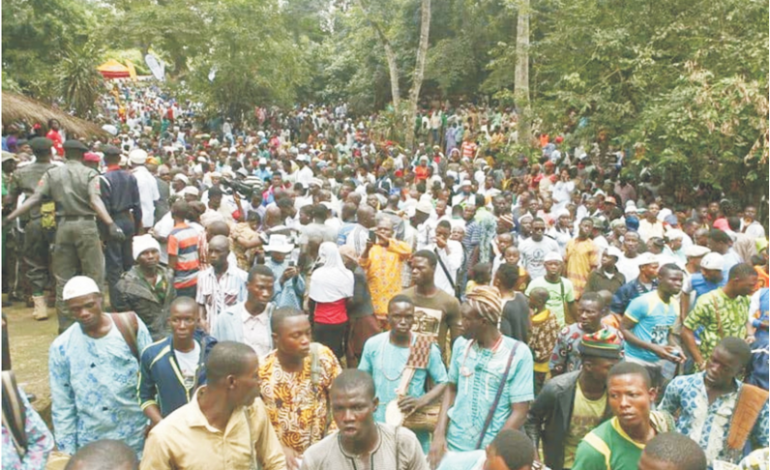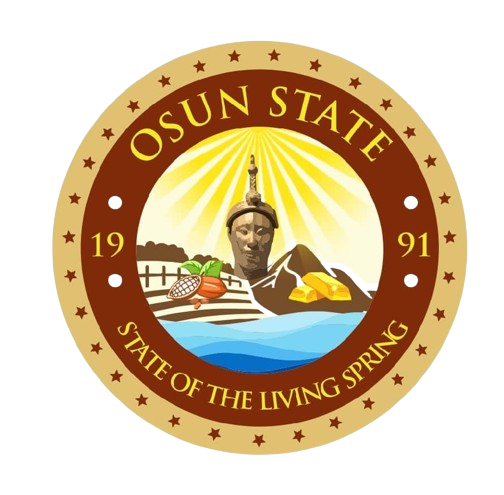
OSUN OSOGBO FESTIVAL: The Glamour, The Excitement
 Osun is known as the land of living spring. The annual Osun Oshogbo festival displays the rich cultural heritage of the Yoruba community for two weeks. The dense forest of the Osun sacred groove, on the outskirts of the city of Oshogbo, is one of the last remnants of primary high forest in the South West Nigeria. Regarded as the abode of the gods of fertility, Osun, one of the pantheons of Yoruba gods, the landscape of the grove and its meandering river is dotted with sanctuaries and shrines, sculptures and art works in honour of Osun and other deities. The sacred grove, which is now seen as a symbol of identity for all Yoruba people, is probably the last in Yoruba culture. It testifies to the once widespread practice of establishing sacred groves outside all settlements.
Osun is known as the land of living spring. The annual Osun Oshogbo festival displays the rich cultural heritage of the Yoruba community for two weeks. The dense forest of the Osun sacred groove, on the outskirts of the city of Oshogbo, is one of the last remnants of primary high forest in the South West Nigeria. Regarded as the abode of the gods of fertility, Osun, one of the pantheons of Yoruba gods, the landscape of the grove and its meandering river is dotted with sanctuaries and shrines, sculptures and art works in honour of Osun and other deities. The sacred grove, which is now seen as a symbol of identity for all Yoruba people, is probably the last in Yoruba culture. It testifies to the once widespread practice of establishing sacred groves outside all settlements.
The form of all socio-cultural developments has so me attributes of celebration and thanksgiving to the Almighty GOD. Festivals are, therefore regarded as important socio – cultural means of supplications to the Supreme Being, at most times through His intermediaries according to different religious faith.
me attributes of celebration and thanksgiving to the Almighty GOD. Festivals are, therefore regarded as important socio – cultural means of supplications to the Supreme Being, at most times through His intermediaries according to different religious faith.
Consequently, the month of august of every year has become a unique month among people of Oshogbo land. It is the month of celebration, traditional cleansing of the city and the cultural reunion of the people with their great ancestors and founders of Oshogbo kingdom. The celebration of Osun Oshogbo festival is a period of stocktaking and assemblage of all son s and daughters of Oshogbo land as well as Yoruba people both in Nigeria and diaspora. The origin of the festival, according to historical records, was an account of the legendary encounter between the early settlers and founders of Oshogbo with the Osun Oshogbo deity. In about 1370AD the founder of Oshogbo, Oba Gbadewolu Larooye, and the great hunter, Olutimehin, settled in the sacred Osun f
s and daughters of Oshogbo land as well as Yoruba people both in Nigeria and diaspora. The origin of the festival, according to historical records, was an account of the legendary encounter between the early settlers and founders of Oshogbo with the Osun Oshogbo deity. In about 1370AD the founder of Oshogbo, Oba Gbadewolu Larooye, and the great hunter, Olutimehin, settled in the sacred Osun f orest to establish the kingdom and actualized a part of association and togetherness with the river Osun deity. Since then, Oshogbo has remained a peaceful progressive and benevolent city. This pact of association which rekindled every year in the month of August is the foundation of a cultural fiesta which has catapulted itself into world recognition as one of the largest tourist attraction locally and internationally. The festival which is the grand finale event of other pro
orest to establish the kingdom and actualized a part of association and togetherness with the river Osun deity. Since then, Oshogbo has remained a peaceful progressive and benevolent city. This pact of association which rekindled every year in the month of August is the foundation of a cultural fiesta which has catapulted itself into world recognition as one of the largest tourist attraction locally and internationally. The festival which is the grand finale event of other pro grams of events starting with the traditional cleansing of the town called iwopopo, followed by the lightening of the 642 years old 16 Points lamp, called “atupaOlujumerindilogun” on the third day. This is followed by iboriade on the fourth day, the assemblage of all the crowns of past rulers (Ataojas) for blessings. Other festivals like egungun, oro, sango, ifa, obatala and Ogunare also celebrated during this time.
grams of events starting with the traditional cleansing of the town called iwopopo, followed by the lightening of the 642 years old 16 Points lamp, called “atupaOlujumerindilogun” on the third day. This is followed by iboriade on the fourth day, the assemblage of all the crowns of past rulers (Ataojas) for blessings. Other festivals like egungun, oro, sango, ifa, obatala and Ogunare also celebrated during this time.
On the last day of the event, i.e. the grand finale, the town was filled with a multitude of people in various attire, mostly in the colour of white, all makin g their way to the palace of the Ataoja (king) Oba Jimoh Olanipekun. The roads were filled with human traffic, group of people were seen wearing the same colour dress singing and dancing. As an annual celebration, people from all nook and crannies look forward to escort the Arugba (the virgin who bears the calabash of sacrifice to the Osun goddess) from the royal family which is the ruling house. She is chosen divinely through the Osun goddess who makes her choice known through the ifa oracle. The Arugba is not just an ordinary teenager, her mission takes place right from her leaving her abode to greet the king with the sacrifice on her head which is covered with a thick orange cloth and she is guarded by bodyguards and Iya Osun. Her face is covered with a cloak and she is under a strong spell, one which gives her the strength she needs throughout the day. She is in trance as she walks the distance from the Ataoja’s palace to
g their way to the palace of the Ataoja (king) Oba Jimoh Olanipekun. The roads were filled with human traffic, group of people were seen wearing the same colour dress singing and dancing. As an annual celebration, people from all nook and crannies look forward to escort the Arugba (the virgin who bears the calabash of sacrifice to the Osun goddess) from the royal family which is the ruling house. She is chosen divinely through the Osun goddess who makes her choice known through the ifa oracle. The Arugba is not just an ordinary teenager, her mission takes place right from her leaving her abode to greet the king with the sacrifice on her head which is covered with a thick orange cloth and she is guarded by bodyguards and Iya Osun. Her face is covered with a cloak and she is under a strong spell, one which gives her the strength she needs throughout the day. She is in trance as she walks the distance from the Ataoja’s palace to the Osun sacred grove, in which incantations are being chanted. The crowd does the same, for they pray and believe that all their problems are gone. Everyone that is around must repeat the prayer, it drives away curses and anyone who refuses to do so is in danger of attracting the rejected curses.
the Osun sacred grove, in which incantations are being chanted. The crowd does the same, for they pray and believe that all their problems are gone. Everyone that is around must repeat the prayer, it drives away curses and anyone who refuses to do so is in danger of attracting the rejected curses.
Present at this year’s festival were the people f rom Trinidad & Tobago, Austria, Philippines, Brazil, France, Cuba, Germany, South- Africa, Ghana, Kenya and Uganda. Nigerian artist and photographers were also present . The Oodua People’s Congress (OPC) of Chief Gani Adams was conspicuously present at this year’s festival.Also present were Christians and Muslims, who prayed to seek answers to their problems in the midst of the crowd, holding hands together, they found their way to the front where a man was seen washing his face with water and also drinking it, while another woman brought in a child, chanting words of thanks to the goddess that allow her to bring the child every year as a gift. They all left with fulfillment.
rom Trinidad & Tobago, Austria, Philippines, Brazil, France, Cuba, Germany, South- Africa, Ghana, Kenya and Uganda. Nigerian artist and photographers were also present . The Oodua People’s Congress (OPC) of Chief Gani Adams was conspicuously present at this year’s festival.Also present were Christians and Muslims, who prayed to seek answers to their problems in the midst of the crowd, holding hands together, they found their way to the front where a man was seen washing his face with water and also drinking it, while another woman brought in a child, chanting words of thanks to the goddess that allow her to bring the child every year as a gift. They all left with fulfillment.
According to Mr. Ayo Olumoko, the Managing Director of INFOGEM Ltd, a cultural consulting firm for the festival, there was an increment from eight foreign countries that participated in the festival last year.
“This is due to the mass publicity given to the festival this year. More participants indica ted their interests to attend this year’s events because we do not have any cases of the Ebola Virus Disease (EVD) challenge the country faced in 2014,” he said.
ted their interests to attend this year’s events because we do not have any cases of the Ebola Virus Disease (EVD) challenge the country faced in 2014,” he said.
Olumoko said that participation by those countries would strengthen their cultural relations with Nigeria. “It will enable citizens of those countries to know and understand the Nigerian culture”. He said that the festival would bring influx of tourists into Osun in particular and Nigeria in general.
The cultural fiesta was organized by the state government, with the support of National Commission for Museum and Monument (NCMM) and many private sectors bodies. The list of sponsors for this year’s event include: MTN Nigeria, Nigerian breweries (Goldberg) Seaman’s Royal, and kasepreko.
The Osun groove was enlisted officially as a world heritage site by United Nations Educational Scientific and Cultural organization (UNESCO) in 2005.
AFRICAN TOURIST



